The Role of Urban Tourism: An Analysis of Borough Market, London
VerifiedAdded on 2023/06/05
|16
|5642
|66
Report
AI Summary
This report explores the concept of urban tourism, focusing on Borough Market in London as a case study. It begins with an introduction to urban tourism, highlighting its growth and significance in the global economy and intercultural communication. The literature review examines various scholars' perspectives on urban tourism's economic, social, and environmental impacts, both positive and negative. The report then delves into Borough Market, describing its history and role as a popular destination attracting millions of tourists annually. The research methodology involves data collection to understand the market's importance and role in local community development. Ultimately, the report aims to shed light on the multifaceted aspects of urban tourism and its impact on urban areas like London, emphasizing the need for sustainable development and effective management of tourism activities.
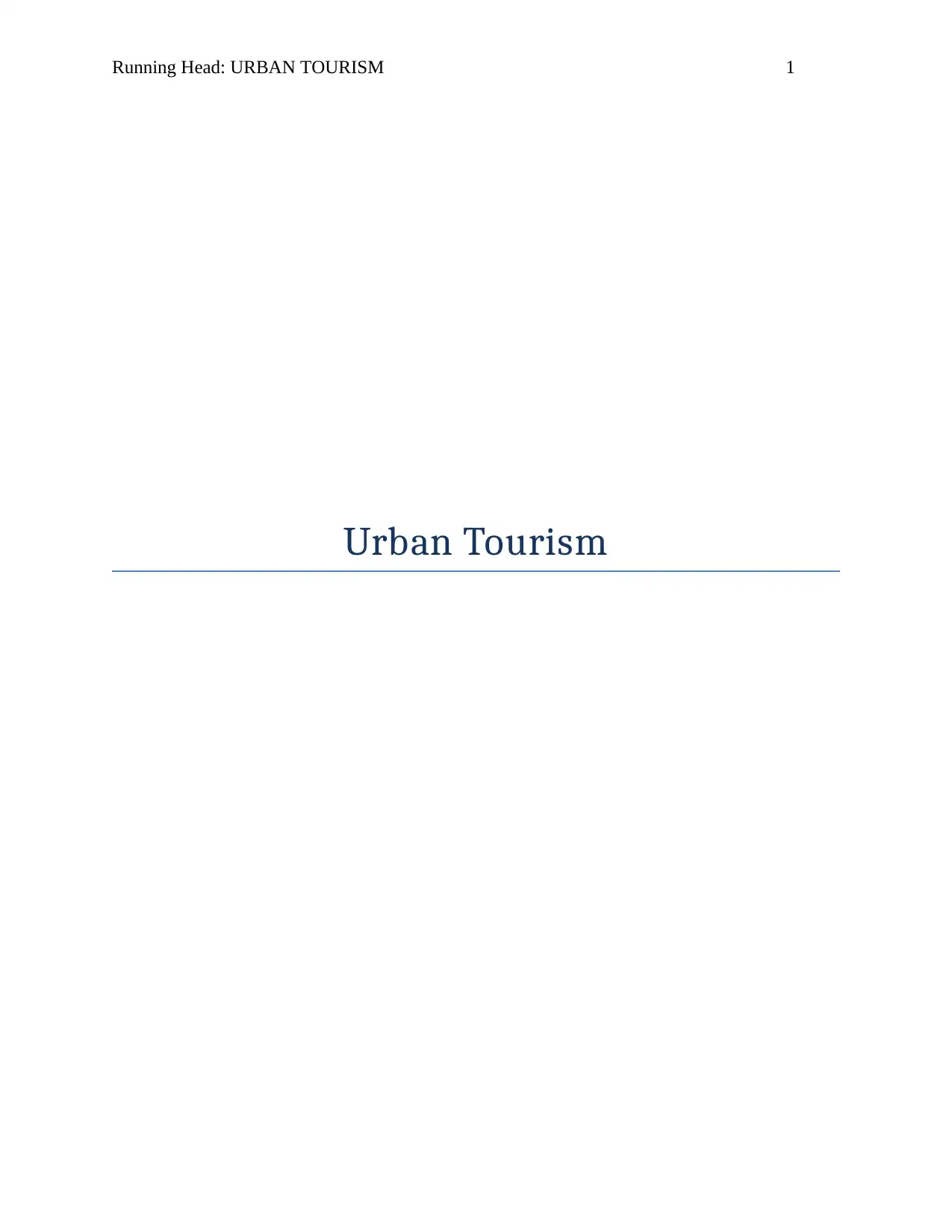
Running Head: URBAN TOURISM 1
Urban Tourism
Urban Tourism
Paraphrase This Document
Need a fresh take? Get an instant paraphrase of this document with our AI Paraphraser
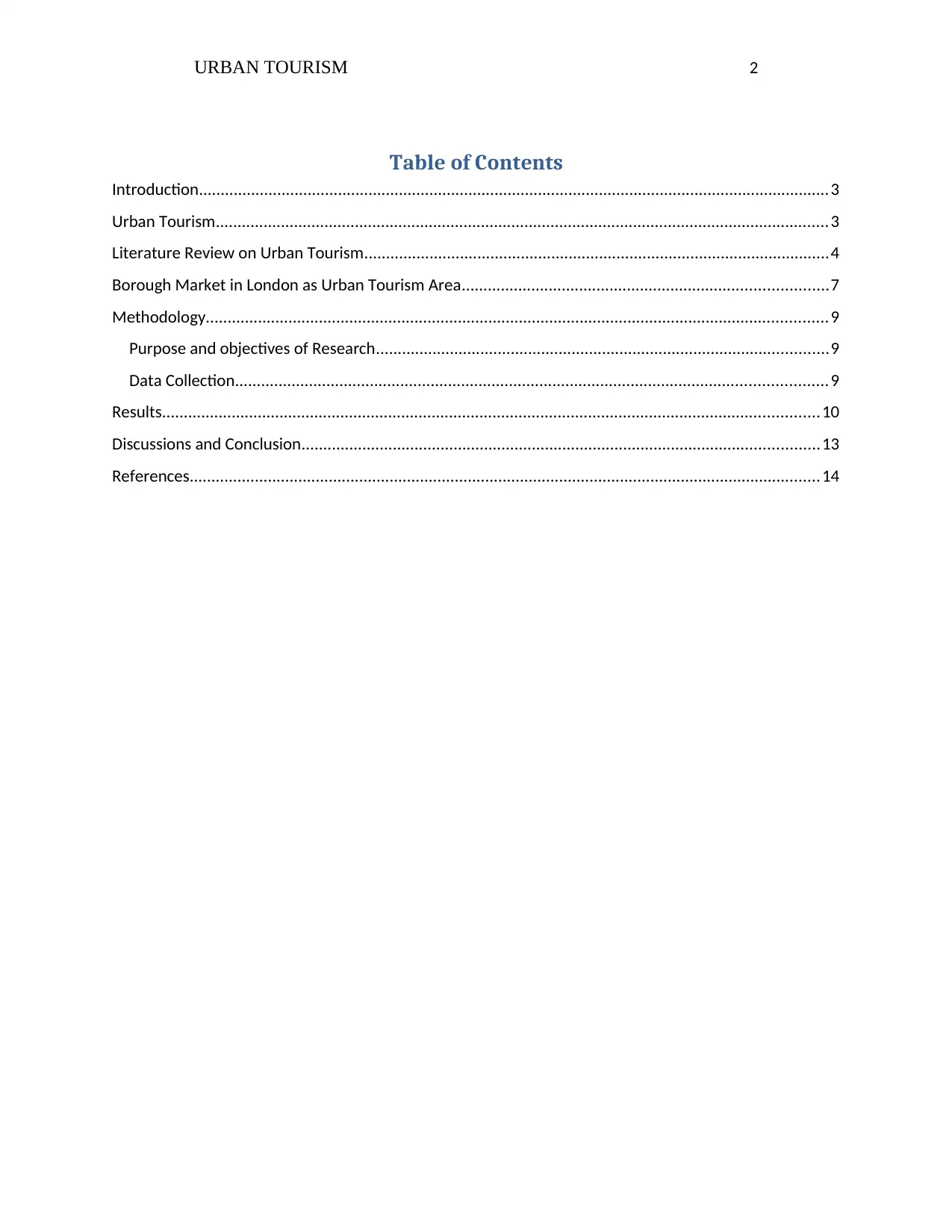
URBAN TOURISM 2
Table of Contents
Introduction.................................................................................................................................................3
Urban Tourism.............................................................................................................................................3
Literature Review on Urban Tourism...........................................................................................................4
Borough Market in London as Urban Tourism Area....................................................................................7
Methodology...............................................................................................................................................9
Purpose and objectives of Research........................................................................................................9
Data Collection........................................................................................................................................9
Results.......................................................................................................................................................10
Discussions and Conclusion.......................................................................................................................13
References.................................................................................................................................................14
Table of Contents
Introduction.................................................................................................................................................3
Urban Tourism.............................................................................................................................................3
Literature Review on Urban Tourism...........................................................................................................4
Borough Market in London as Urban Tourism Area....................................................................................7
Methodology...............................................................................................................................................9
Purpose and objectives of Research........................................................................................................9
Data Collection........................................................................................................................................9
Results.......................................................................................................................................................10
Discussions and Conclusion.......................................................................................................................13
References.................................................................................................................................................14
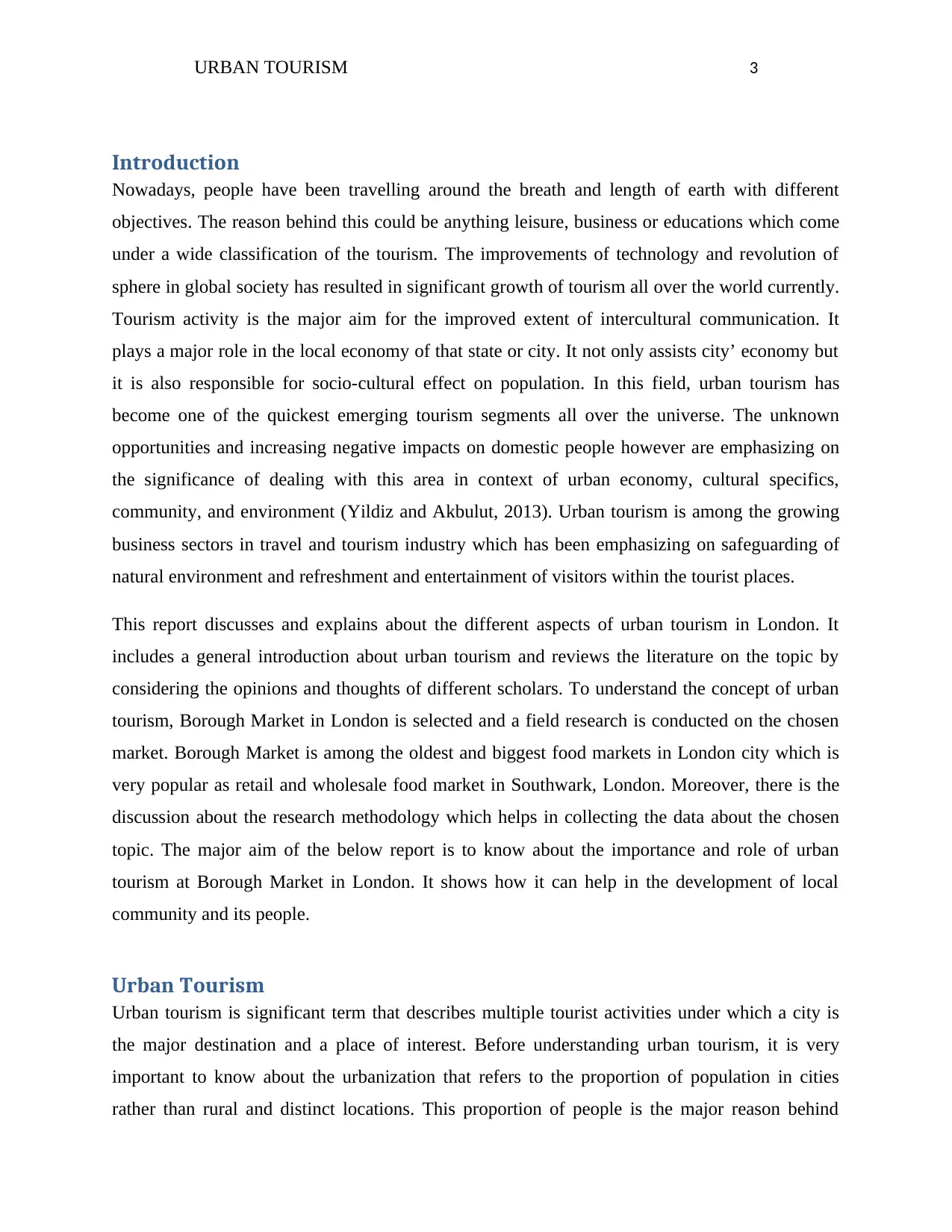
URBAN TOURISM 3
Introduction
Nowadays, people have been travelling around the breath and length of earth with different
objectives. The reason behind this could be anything leisure, business or educations which come
under a wide classification of the tourism. The improvements of technology and revolution of
sphere in global society has resulted in significant growth of tourism all over the world currently.
Tourism activity is the major aim for the improved extent of intercultural communication. It
plays a major role in the local economy of that state or city. It not only assists city’ economy but
it is also responsible for socio-cultural effect on population. In this field, urban tourism has
become one of the quickest emerging tourism segments all over the universe. The unknown
opportunities and increasing negative impacts on domestic people however are emphasizing on
the significance of dealing with this area in context of urban economy, cultural specifics,
community, and environment (Yildiz and Akbulut, 2013). Urban tourism is among the growing
business sectors in travel and tourism industry which has been emphasizing on safeguarding of
natural environment and refreshment and entertainment of visitors within the tourist places.
This report discusses and explains about the different aspects of urban tourism in London. It
includes a general introduction about urban tourism and reviews the literature on the topic by
considering the opinions and thoughts of different scholars. To understand the concept of urban
tourism, Borough Market in London is selected and a field research is conducted on the chosen
market. Borough Market is among the oldest and biggest food markets in London city which is
very popular as retail and wholesale food market in Southwark, London. Moreover, there is the
discussion about the research methodology which helps in collecting the data about the chosen
topic. The major aim of the below report is to know about the importance and role of urban
tourism at Borough Market in London. It shows how it can help in the development of local
community and its people.
Urban Tourism
Urban tourism is significant term that describes multiple tourist activities under which a city is
the major destination and a place of interest. Before understanding urban tourism, it is very
important to know about the urbanization that refers to the proportion of population in cities
rather than rural and distinct locations. This proportion of people is the major reason behind
Introduction
Nowadays, people have been travelling around the breath and length of earth with different
objectives. The reason behind this could be anything leisure, business or educations which come
under a wide classification of the tourism. The improvements of technology and revolution of
sphere in global society has resulted in significant growth of tourism all over the world currently.
Tourism activity is the major aim for the improved extent of intercultural communication. It
plays a major role in the local economy of that state or city. It not only assists city’ economy but
it is also responsible for socio-cultural effect on population. In this field, urban tourism has
become one of the quickest emerging tourism segments all over the universe. The unknown
opportunities and increasing negative impacts on domestic people however are emphasizing on
the significance of dealing with this area in context of urban economy, cultural specifics,
community, and environment (Yildiz and Akbulut, 2013). Urban tourism is among the growing
business sectors in travel and tourism industry which has been emphasizing on safeguarding of
natural environment and refreshment and entertainment of visitors within the tourist places.
This report discusses and explains about the different aspects of urban tourism in London. It
includes a general introduction about urban tourism and reviews the literature on the topic by
considering the opinions and thoughts of different scholars. To understand the concept of urban
tourism, Borough Market in London is selected and a field research is conducted on the chosen
market. Borough Market is among the oldest and biggest food markets in London city which is
very popular as retail and wholesale food market in Southwark, London. Moreover, there is the
discussion about the research methodology which helps in collecting the data about the chosen
topic. The major aim of the below report is to know about the importance and role of urban
tourism at Borough Market in London. It shows how it can help in the development of local
community and its people.
Urban Tourism
Urban tourism is significant term that describes multiple tourist activities under which a city is
the major destination and a place of interest. Before understanding urban tourism, it is very
important to know about the urbanization that refers to the proportion of population in cities
rather than rural and distinct locations. This proportion of people is the major reason behind
⊘ This is a preview!⊘
Do you want full access?
Subscribe today to unlock all pages.

Trusted by 1+ million students worldwide
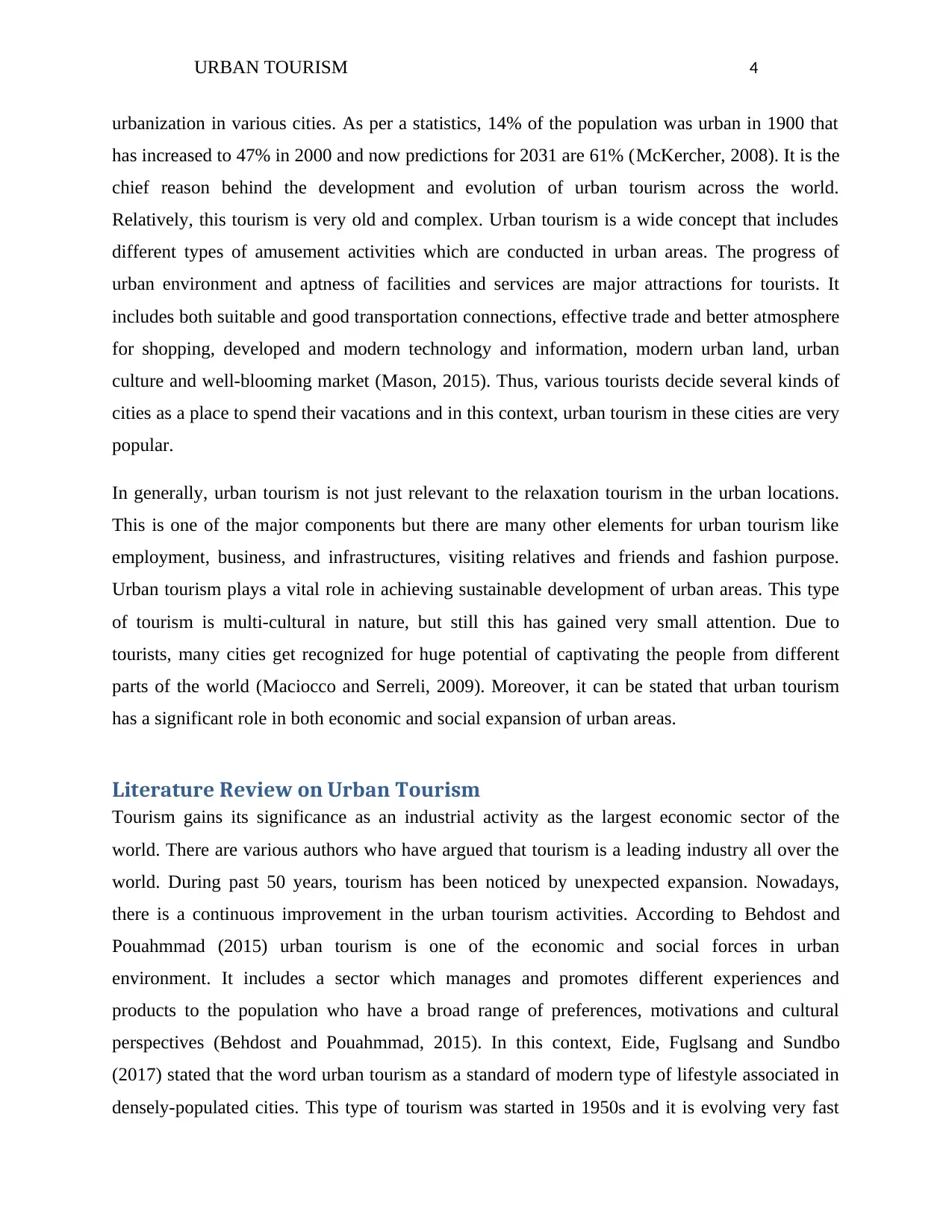
URBAN TOURISM 4
urbanization in various cities. As per a statistics, 14% of the population was urban in 1900 that
has increased to 47% in 2000 and now predictions for 2031 are 61% (McKercher, 2008). It is the
chief reason behind the development and evolution of urban tourism across the world.
Relatively, this tourism is very old and complex. Urban tourism is a wide concept that includes
different types of amusement activities which are conducted in urban areas. The progress of
urban environment and aptness of facilities and services are major attractions for tourists. It
includes both suitable and good transportation connections, effective trade and better atmosphere
for shopping, developed and modern technology and information, modern urban land, urban
culture and well-blooming market (Mason, 2015). Thus, various tourists decide several kinds of
cities as a place to spend their vacations and in this context, urban tourism in these cities are very
popular.
In generally, urban tourism is not just relevant to the relaxation tourism in the urban locations.
This is one of the major components but there are many other elements for urban tourism like
employment, business, and infrastructures, visiting relatives and friends and fashion purpose.
Urban tourism plays a vital role in achieving sustainable development of urban areas. This type
of tourism is multi-cultural in nature, but still this has gained very small attention. Due to
tourists, many cities get recognized for huge potential of captivating the people from different
parts of the world (Maciocco and Serreli, 2009). Moreover, it can be stated that urban tourism
has a significant role in both economic and social expansion of urban areas.
Literature Review on Urban Tourism
Tourism gains its significance as an industrial activity as the largest economic sector of the
world. There are various authors who have argued that tourism is a leading industry all over the
world. During past 50 years, tourism has been noticed by unexpected expansion. Nowadays,
there is a continuous improvement in the urban tourism activities. According to Behdost and
Pouahmmad (2015) urban tourism is one of the economic and social forces in urban
environment. It includes a sector which manages and promotes different experiences and
products to the population who have a broad range of preferences, motivations and cultural
perspectives (Behdost and Pouahmmad, 2015). In this context, Eide, Fuglsang and Sundbo
(2017) stated that the word urban tourism as a standard of modern type of lifestyle associated in
densely-populated cities. This type of tourism was started in 1950s and it is evolving very fast
urbanization in various cities. As per a statistics, 14% of the population was urban in 1900 that
has increased to 47% in 2000 and now predictions for 2031 are 61% (McKercher, 2008). It is the
chief reason behind the development and evolution of urban tourism across the world.
Relatively, this tourism is very old and complex. Urban tourism is a wide concept that includes
different types of amusement activities which are conducted in urban areas. The progress of
urban environment and aptness of facilities and services are major attractions for tourists. It
includes both suitable and good transportation connections, effective trade and better atmosphere
for shopping, developed and modern technology and information, modern urban land, urban
culture and well-blooming market (Mason, 2015). Thus, various tourists decide several kinds of
cities as a place to spend their vacations and in this context, urban tourism in these cities are very
popular.
In generally, urban tourism is not just relevant to the relaxation tourism in the urban locations.
This is one of the major components but there are many other elements for urban tourism like
employment, business, and infrastructures, visiting relatives and friends and fashion purpose.
Urban tourism plays a vital role in achieving sustainable development of urban areas. This type
of tourism is multi-cultural in nature, but still this has gained very small attention. Due to
tourists, many cities get recognized for huge potential of captivating the people from different
parts of the world (Maciocco and Serreli, 2009). Moreover, it can be stated that urban tourism
has a significant role in both economic and social expansion of urban areas.
Literature Review on Urban Tourism
Tourism gains its significance as an industrial activity as the largest economic sector of the
world. There are various authors who have argued that tourism is a leading industry all over the
world. During past 50 years, tourism has been noticed by unexpected expansion. Nowadays,
there is a continuous improvement in the urban tourism activities. According to Behdost and
Pouahmmad (2015) urban tourism is one of the economic and social forces in urban
environment. It includes a sector which manages and promotes different experiences and
products to the population who have a broad range of preferences, motivations and cultural
perspectives (Behdost and Pouahmmad, 2015). In this context, Eide, Fuglsang and Sundbo
(2017) stated that the word urban tourism as a standard of modern type of lifestyle associated in
densely-populated cities. This type of tourism was started in 1950s and it is evolving very fast
Paraphrase This Document
Need a fresh take? Get an instant paraphrase of this document with our AI Paraphraser
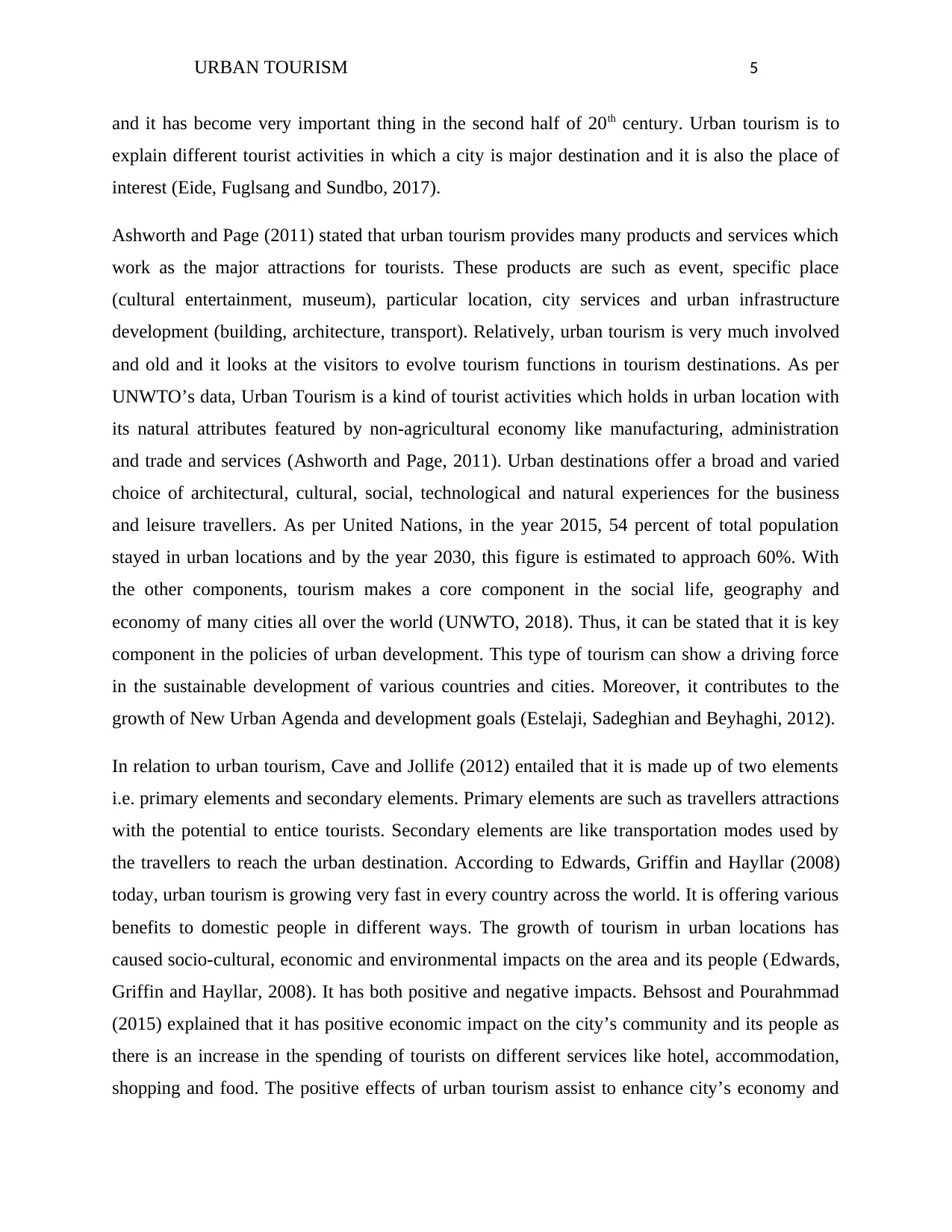
URBAN TOURISM 5
and it has become very important thing in the second half of 20th century. Urban tourism is to
explain different tourist activities in which a city is major destination and it is also the place of
interest (Eide, Fuglsang and Sundbo, 2017).
Ashworth and Page (2011) stated that urban tourism provides many products and services which
work as the major attractions for tourists. These products are such as event, specific place
(cultural entertainment, museum), particular location, city services and urban infrastructure
development (building, architecture, transport). Relatively, urban tourism is very much involved
and old and it looks at the visitors to evolve tourism functions in tourism destinations. As per
UNWTO’s data, Urban Tourism is a kind of tourist activities which holds in urban location with
its natural attributes featured by non-agricultural economy like manufacturing, administration
and trade and services (Ashworth and Page, 2011). Urban destinations offer a broad and varied
choice of architectural, cultural, social, technological and natural experiences for the business
and leisure travellers. As per United Nations, in the year 2015, 54 percent of total population
stayed in urban locations and by the year 2030, this figure is estimated to approach 60%. With
the other components, tourism makes a core component in the social life, geography and
economy of many cities all over the world (UNWTO, 2018). Thus, it can be stated that it is key
component in the policies of urban development. This type of tourism can show a driving force
in the sustainable development of various countries and cities. Moreover, it contributes to the
growth of New Urban Agenda and development goals (Estelaji, Sadeghian and Beyhaghi, 2012).
In relation to urban tourism, Cave and Jollife (2012) entailed that it is made up of two elements
i.e. primary elements and secondary elements. Primary elements are such as travellers attractions
with the potential to entice tourists. Secondary elements are like transportation modes used by
the travellers to reach the urban destination. According to Edwards, Griffin and Hayllar (2008)
today, urban tourism is growing very fast in every country across the world. It is offering various
benefits to domestic people in different ways. The growth of tourism in urban locations has
caused socio-cultural, economic and environmental impacts on the area and its people (Edwards,
Griffin and Hayllar, 2008). It has both positive and negative impacts. Behsost and Pourahmmad
(2015) explained that it has positive economic impact on the city’s community and its people as
there is an increase in the spending of tourists on different services like hotel, accommodation,
shopping and food. The positive effects of urban tourism assist to enhance city’s economy and
and it has become very important thing in the second half of 20th century. Urban tourism is to
explain different tourist activities in which a city is major destination and it is also the place of
interest (Eide, Fuglsang and Sundbo, 2017).
Ashworth and Page (2011) stated that urban tourism provides many products and services which
work as the major attractions for tourists. These products are such as event, specific place
(cultural entertainment, museum), particular location, city services and urban infrastructure
development (building, architecture, transport). Relatively, urban tourism is very much involved
and old and it looks at the visitors to evolve tourism functions in tourism destinations. As per
UNWTO’s data, Urban Tourism is a kind of tourist activities which holds in urban location with
its natural attributes featured by non-agricultural economy like manufacturing, administration
and trade and services (Ashworth and Page, 2011). Urban destinations offer a broad and varied
choice of architectural, cultural, social, technological and natural experiences for the business
and leisure travellers. As per United Nations, in the year 2015, 54 percent of total population
stayed in urban locations and by the year 2030, this figure is estimated to approach 60%. With
the other components, tourism makes a core component in the social life, geography and
economy of many cities all over the world (UNWTO, 2018). Thus, it can be stated that it is key
component in the policies of urban development. This type of tourism can show a driving force
in the sustainable development of various countries and cities. Moreover, it contributes to the
growth of New Urban Agenda and development goals (Estelaji, Sadeghian and Beyhaghi, 2012).
In relation to urban tourism, Cave and Jollife (2012) entailed that it is made up of two elements
i.e. primary elements and secondary elements. Primary elements are such as travellers attractions
with the potential to entice tourists. Secondary elements are like transportation modes used by
the travellers to reach the urban destination. According to Edwards, Griffin and Hayllar (2008)
today, urban tourism is growing very fast in every country across the world. It is offering various
benefits to domestic people in different ways. The growth of tourism in urban locations has
caused socio-cultural, economic and environmental impacts on the area and its people (Edwards,
Griffin and Hayllar, 2008). It has both positive and negative impacts. Behsost and Pourahmmad
(2015) explained that it has positive economic impact on the city’s community and its people as
there is an increase in the spending of tourists on different services like hotel, accommodation,
shopping and food. The positive effects of urban tourism assist to enhance city’s economy and
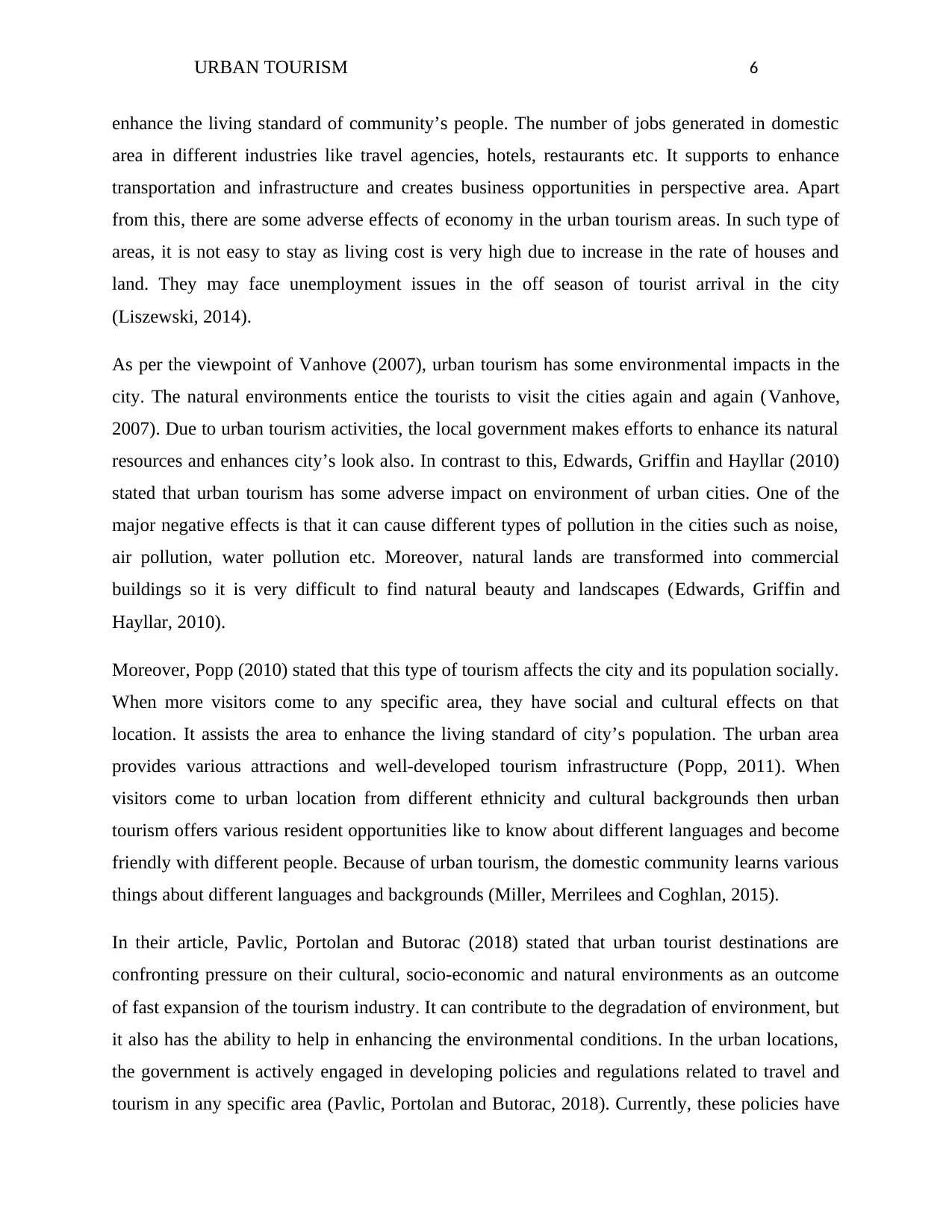
URBAN TOURISM 6
enhance the living standard of community’s people. The number of jobs generated in domestic
area in different industries like travel agencies, hotels, restaurants etc. It supports to enhance
transportation and infrastructure and creates business opportunities in perspective area. Apart
from this, there are some adverse effects of economy in the urban tourism areas. In such type of
areas, it is not easy to stay as living cost is very high due to increase in the rate of houses and
land. They may face unemployment issues in the off season of tourist arrival in the city
(Liszewski, 2014).
As per the viewpoint of Vanhove (2007), urban tourism has some environmental impacts in the
city. The natural environments entice the tourists to visit the cities again and again (Vanhove,
2007). Due to urban tourism activities, the local government makes efforts to enhance its natural
resources and enhances city’s look also. In contrast to this, Edwards, Griffin and Hayllar (2010)
stated that urban tourism has some adverse impact on environment of urban cities. One of the
major negative effects is that it can cause different types of pollution in the cities such as noise,
air pollution, water pollution etc. Moreover, natural lands are transformed into commercial
buildings so it is very difficult to find natural beauty and landscapes (Edwards, Griffin and
Hayllar, 2010).
Moreover, Popp (2010) stated that this type of tourism affects the city and its population socially.
When more visitors come to any specific area, they have social and cultural effects on that
location. It assists the area to enhance the living standard of city’s population. The urban area
provides various attractions and well-developed tourism infrastructure (Popp, 2011). When
visitors come to urban location from different ethnicity and cultural backgrounds then urban
tourism offers various resident opportunities like to know about different languages and become
friendly with different people. Because of urban tourism, the domestic community learns various
things about different languages and backgrounds (Miller, Merrilees and Coghlan, 2015).
In their article, Pavlic, Portolan and Butorac (2018) stated that urban tourist destinations are
confronting pressure on their cultural, socio-economic and natural environments as an outcome
of fast expansion of the tourism industry. It can contribute to the degradation of environment, but
it also has the ability to help in enhancing the environmental conditions. In the urban locations,
the government is actively engaged in developing policies and regulations related to travel and
tourism in any specific area (Pavlic, Portolan and Butorac, 2018). Currently, these policies have
enhance the living standard of community’s people. The number of jobs generated in domestic
area in different industries like travel agencies, hotels, restaurants etc. It supports to enhance
transportation and infrastructure and creates business opportunities in perspective area. Apart
from this, there are some adverse effects of economy in the urban tourism areas. In such type of
areas, it is not easy to stay as living cost is very high due to increase in the rate of houses and
land. They may face unemployment issues in the off season of tourist arrival in the city
(Liszewski, 2014).
As per the viewpoint of Vanhove (2007), urban tourism has some environmental impacts in the
city. The natural environments entice the tourists to visit the cities again and again (Vanhove,
2007). Due to urban tourism activities, the local government makes efforts to enhance its natural
resources and enhances city’s look also. In contrast to this, Edwards, Griffin and Hayllar (2010)
stated that urban tourism has some adverse impact on environment of urban cities. One of the
major negative effects is that it can cause different types of pollution in the cities such as noise,
air pollution, water pollution etc. Moreover, natural lands are transformed into commercial
buildings so it is very difficult to find natural beauty and landscapes (Edwards, Griffin and
Hayllar, 2010).
Moreover, Popp (2010) stated that this type of tourism affects the city and its population socially.
When more visitors come to any specific area, they have social and cultural effects on that
location. It assists the area to enhance the living standard of city’s population. The urban area
provides various attractions and well-developed tourism infrastructure (Popp, 2011). When
visitors come to urban location from different ethnicity and cultural backgrounds then urban
tourism offers various resident opportunities like to know about different languages and become
friendly with different people. Because of urban tourism, the domestic community learns various
things about different languages and backgrounds (Miller, Merrilees and Coghlan, 2015).
In their article, Pavlic, Portolan and Butorac (2018) stated that urban tourist destinations are
confronting pressure on their cultural, socio-economic and natural environments as an outcome
of fast expansion of the tourism industry. It can contribute to the degradation of environment, but
it also has the ability to help in enhancing the environmental conditions. In the urban locations,
the government is actively engaged in developing policies and regulations related to travel and
tourism in any specific area (Pavlic, Portolan and Butorac, 2018). Currently, these policies have
⊘ This is a preview!⊘
Do you want full access?
Subscribe today to unlock all pages.

Trusted by 1+ million students worldwide
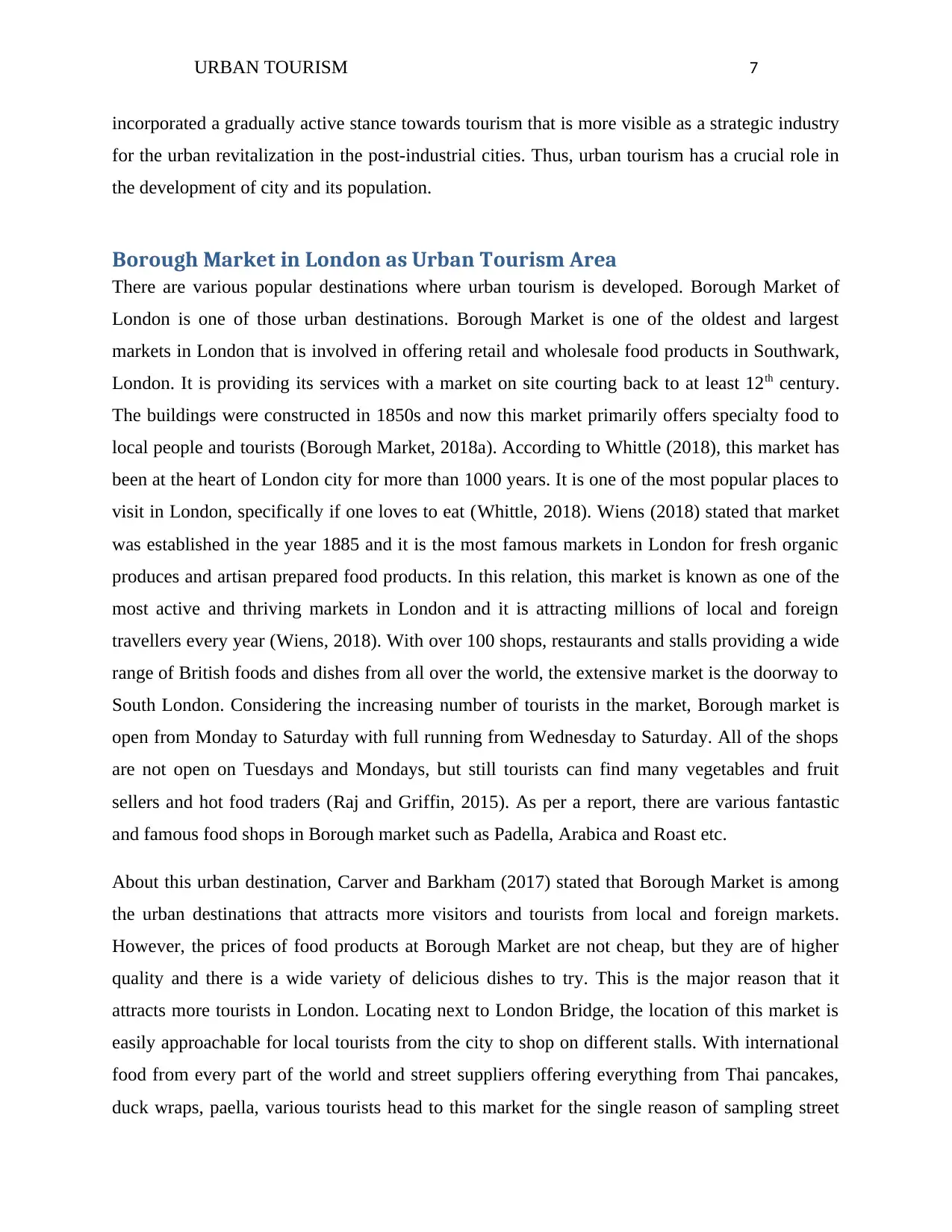
URBAN TOURISM 7
incorporated a gradually active stance towards tourism that is more visible as a strategic industry
for the urban revitalization in the post-industrial cities. Thus, urban tourism has a crucial role in
the development of city and its population.
Borough Market in London as Urban Tourism Area
There are various popular destinations where urban tourism is developed. Borough Market of
London is one of those urban destinations. Borough Market is one of the oldest and largest
markets in London that is involved in offering retail and wholesale food products in Southwark,
London. It is providing its services with a market on site courting back to at least 12th century.
The buildings were constructed in 1850s and now this market primarily offers specialty food to
local people and tourists (Borough Market, 2018a). According to Whittle (2018), this market has
been at the heart of London city for more than 1000 years. It is one of the most popular places to
visit in London, specifically if one loves to eat (Whittle, 2018). Wiens (2018) stated that market
was established in the year 1885 and it is the most famous markets in London for fresh organic
produces and artisan prepared food products. In this relation, this market is known as one of the
most active and thriving markets in London and it is attracting millions of local and foreign
travellers every year (Wiens, 2018). With over 100 shops, restaurants and stalls providing a wide
range of British foods and dishes from all over the world, the extensive market is the doorway to
South London. Considering the increasing number of tourists in the market, Borough market is
open from Monday to Saturday with full running from Wednesday to Saturday. All of the shops
are not open on Tuesdays and Mondays, but still tourists can find many vegetables and fruit
sellers and hot food traders (Raj and Griffin, 2015). As per a report, there are various fantastic
and famous food shops in Borough market such as Padella, Arabica and Roast etc.
About this urban destination, Carver and Barkham (2017) stated that Borough Market is among
the urban destinations that attracts more visitors and tourists from local and foreign markets.
However, the prices of food products at Borough Market are not cheap, but they are of higher
quality and there is a wide variety of delicious dishes to try. This is the major reason that it
attracts more tourists in London. Locating next to London Bridge, the location of this market is
easily approachable for local tourists from the city to shop on different stalls. With international
food from every part of the world and street suppliers offering everything from Thai pancakes,
duck wraps, paella, various tourists head to this market for the single reason of sampling street
incorporated a gradually active stance towards tourism that is more visible as a strategic industry
for the urban revitalization in the post-industrial cities. Thus, urban tourism has a crucial role in
the development of city and its population.
Borough Market in London as Urban Tourism Area
There are various popular destinations where urban tourism is developed. Borough Market of
London is one of those urban destinations. Borough Market is one of the oldest and largest
markets in London that is involved in offering retail and wholesale food products in Southwark,
London. It is providing its services with a market on site courting back to at least 12th century.
The buildings were constructed in 1850s and now this market primarily offers specialty food to
local people and tourists (Borough Market, 2018a). According to Whittle (2018), this market has
been at the heart of London city for more than 1000 years. It is one of the most popular places to
visit in London, specifically if one loves to eat (Whittle, 2018). Wiens (2018) stated that market
was established in the year 1885 and it is the most famous markets in London for fresh organic
produces and artisan prepared food products. In this relation, this market is known as one of the
most active and thriving markets in London and it is attracting millions of local and foreign
travellers every year (Wiens, 2018). With over 100 shops, restaurants and stalls providing a wide
range of British foods and dishes from all over the world, the extensive market is the doorway to
South London. Considering the increasing number of tourists in the market, Borough market is
open from Monday to Saturday with full running from Wednesday to Saturday. All of the shops
are not open on Tuesdays and Mondays, but still tourists can find many vegetables and fruit
sellers and hot food traders (Raj and Griffin, 2015). As per a report, there are various fantastic
and famous food shops in Borough market such as Padella, Arabica and Roast etc.
About this urban destination, Carver and Barkham (2017) stated that Borough Market is among
the urban destinations that attracts more visitors and tourists from local and foreign markets.
However, the prices of food products at Borough Market are not cheap, but they are of higher
quality and there is a wide variety of delicious dishes to try. This is the major reason that it
attracts more tourists in London. Locating next to London Bridge, the location of this market is
easily approachable for local tourists from the city to shop on different stalls. With international
food from every part of the world and street suppliers offering everything from Thai pancakes,
duck wraps, paella, various tourists head to this market for the single reason of sampling street
Paraphrase This Document
Need a fresh take? Get an instant paraphrase of this document with our AI Paraphraser
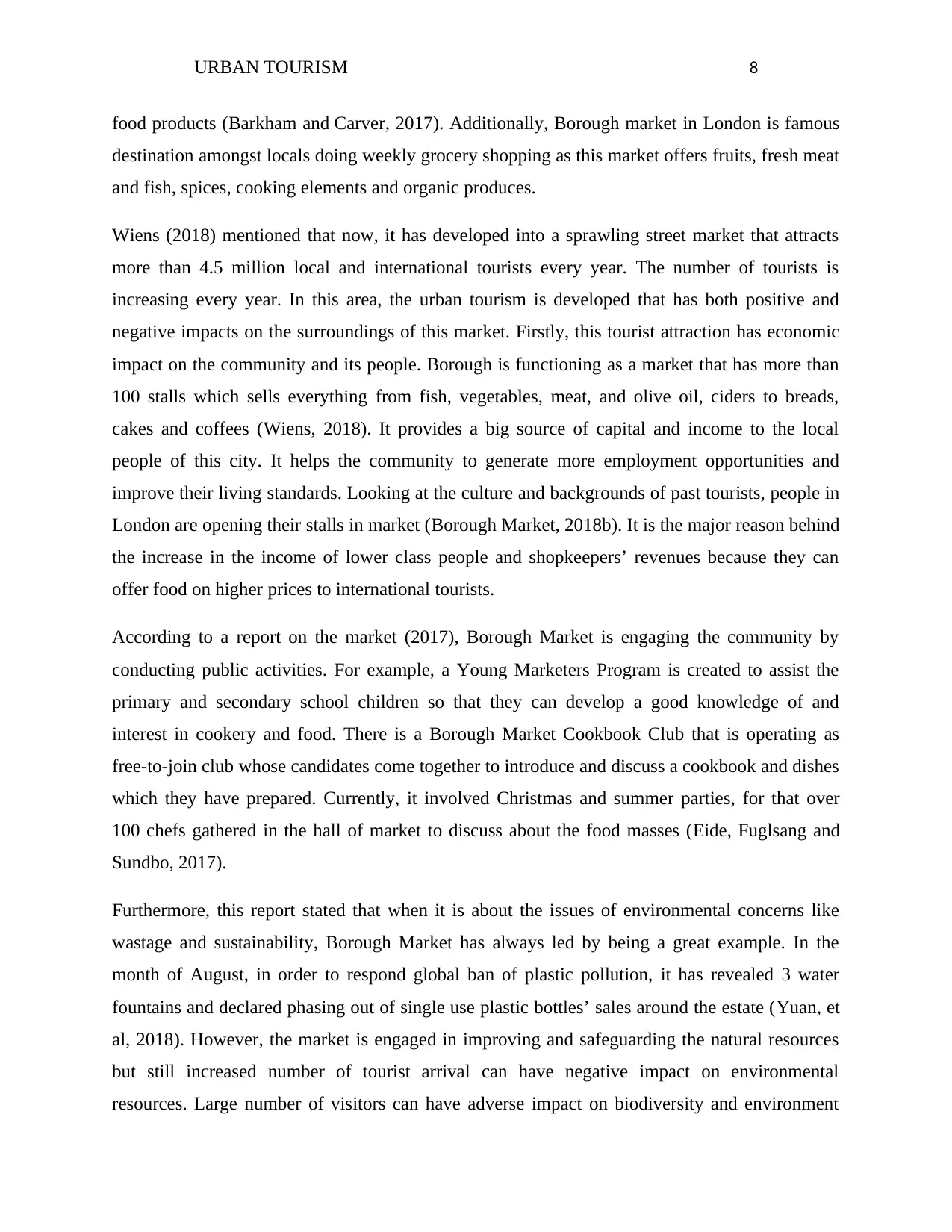
URBAN TOURISM 8
food products (Barkham and Carver, 2017). Additionally, Borough market in London is famous
destination amongst locals doing weekly grocery shopping as this market offers fruits, fresh meat
and fish, spices, cooking elements and organic produces.
Wiens (2018) mentioned that now, it has developed into a sprawling street market that attracts
more than 4.5 million local and international tourists every year. The number of tourists is
increasing every year. In this area, the urban tourism is developed that has both positive and
negative impacts on the surroundings of this market. Firstly, this tourist attraction has economic
impact on the community and its people. Borough is functioning as a market that has more than
100 stalls which sells everything from fish, vegetables, meat, and olive oil, ciders to breads,
cakes and coffees (Wiens, 2018). It provides a big source of capital and income to the local
people of this city. It helps the community to generate more employment opportunities and
improve their living standards. Looking at the culture and backgrounds of past tourists, people in
London are opening their stalls in market (Borough Market, 2018b). It is the major reason behind
the increase in the income of lower class people and shopkeepers’ revenues because they can
offer food on higher prices to international tourists.
According to a report on the market (2017), Borough Market is engaging the community by
conducting public activities. For example, a Young Marketers Program is created to assist the
primary and secondary school children so that they can develop a good knowledge of and
interest in cookery and food. There is a Borough Market Cookbook Club that is operating as
free-to-join club whose candidates come together to introduce and discuss a cookbook and dishes
which they have prepared. Currently, it involved Christmas and summer parties, for that over
100 chefs gathered in the hall of market to discuss about the food masses (Eide, Fuglsang and
Sundbo, 2017).
Furthermore, this report stated that when it is about the issues of environmental concerns like
wastage and sustainability, Borough Market has always led by being a great example. In the
month of August, in order to respond global ban of plastic pollution, it has revealed 3 water
fountains and declared phasing out of single use plastic bottles’ sales around the estate (Yuan, et
al, 2018). However, the market is engaged in improving and safeguarding the natural resources
but still increased number of tourist arrival can have negative impact on environmental
resources. Large number of visitors can have adverse impact on biodiversity and environment
food products (Barkham and Carver, 2017). Additionally, Borough market in London is famous
destination amongst locals doing weekly grocery shopping as this market offers fruits, fresh meat
and fish, spices, cooking elements and organic produces.
Wiens (2018) mentioned that now, it has developed into a sprawling street market that attracts
more than 4.5 million local and international tourists every year. The number of tourists is
increasing every year. In this area, the urban tourism is developed that has both positive and
negative impacts on the surroundings of this market. Firstly, this tourist attraction has economic
impact on the community and its people. Borough is functioning as a market that has more than
100 stalls which sells everything from fish, vegetables, meat, and olive oil, ciders to breads,
cakes and coffees (Wiens, 2018). It provides a big source of capital and income to the local
people of this city. It helps the community to generate more employment opportunities and
improve their living standards. Looking at the culture and backgrounds of past tourists, people in
London are opening their stalls in market (Borough Market, 2018b). It is the major reason behind
the increase in the income of lower class people and shopkeepers’ revenues because they can
offer food on higher prices to international tourists.
According to a report on the market (2017), Borough Market is engaging the community by
conducting public activities. For example, a Young Marketers Program is created to assist the
primary and secondary school children so that they can develop a good knowledge of and
interest in cookery and food. There is a Borough Market Cookbook Club that is operating as
free-to-join club whose candidates come together to introduce and discuss a cookbook and dishes
which they have prepared. Currently, it involved Christmas and summer parties, for that over
100 chefs gathered in the hall of market to discuss about the food masses (Eide, Fuglsang and
Sundbo, 2017).
Furthermore, this report stated that when it is about the issues of environmental concerns like
wastage and sustainability, Borough Market has always led by being a great example. In the
month of August, in order to respond global ban of plastic pollution, it has revealed 3 water
fountains and declared phasing out of single use plastic bottles’ sales around the estate (Yuan, et
al, 2018). However, the market is engaged in improving and safeguarding the natural resources
but still increased number of tourist arrival can have negative impact on environmental
resources. Large number of visitors can have adverse impact on biodiversity and environment
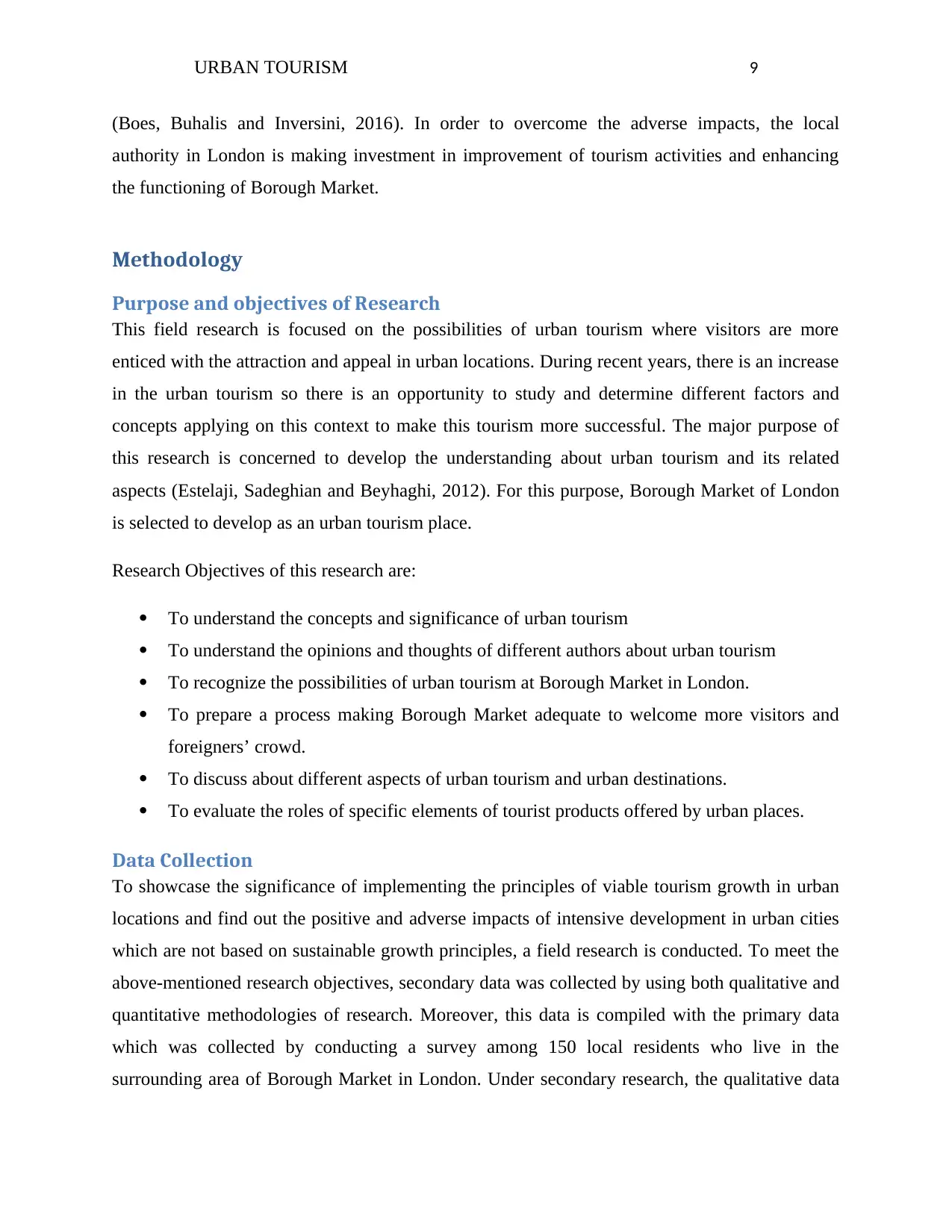
URBAN TOURISM 9
(Boes, Buhalis and Inversini, 2016). In order to overcome the adverse impacts, the local
authority in London is making investment in improvement of tourism activities and enhancing
the functioning of Borough Market.
Methodology
Purpose and objectives of Research
This field research is focused on the possibilities of urban tourism where visitors are more
enticed with the attraction and appeal in urban locations. During recent years, there is an increase
in the urban tourism so there is an opportunity to study and determine different factors and
concepts applying on this context to make this tourism more successful. The major purpose of
this research is concerned to develop the understanding about urban tourism and its related
aspects (Estelaji, Sadeghian and Beyhaghi, 2012). For this purpose, Borough Market of London
is selected to develop as an urban tourism place.
Research Objectives of this research are:
To understand the concepts and significance of urban tourism
To understand the opinions and thoughts of different authors about urban tourism
To recognize the possibilities of urban tourism at Borough Market in London.
To prepare a process making Borough Market adequate to welcome more visitors and
foreigners’ crowd.
To discuss about different aspects of urban tourism and urban destinations.
To evaluate the roles of specific elements of tourist products offered by urban places.
Data Collection
To showcase the significance of implementing the principles of viable tourism growth in urban
locations and find out the positive and adverse impacts of intensive development in urban cities
which are not based on sustainable growth principles, a field research is conducted. To meet the
above-mentioned research objectives, secondary data was collected by using both qualitative and
quantitative methodologies of research. Moreover, this data is compiled with the primary data
which was collected by conducting a survey among 150 local residents who live in the
surrounding area of Borough Market in London. Under secondary research, the qualitative data
(Boes, Buhalis and Inversini, 2016). In order to overcome the adverse impacts, the local
authority in London is making investment in improvement of tourism activities and enhancing
the functioning of Borough Market.
Methodology
Purpose and objectives of Research
This field research is focused on the possibilities of urban tourism where visitors are more
enticed with the attraction and appeal in urban locations. During recent years, there is an increase
in the urban tourism so there is an opportunity to study and determine different factors and
concepts applying on this context to make this tourism more successful. The major purpose of
this research is concerned to develop the understanding about urban tourism and its related
aspects (Estelaji, Sadeghian and Beyhaghi, 2012). For this purpose, Borough Market of London
is selected to develop as an urban tourism place.
Research Objectives of this research are:
To understand the concepts and significance of urban tourism
To understand the opinions and thoughts of different authors about urban tourism
To recognize the possibilities of urban tourism at Borough Market in London.
To prepare a process making Borough Market adequate to welcome more visitors and
foreigners’ crowd.
To discuss about different aspects of urban tourism and urban destinations.
To evaluate the roles of specific elements of tourist products offered by urban places.
Data Collection
To showcase the significance of implementing the principles of viable tourism growth in urban
locations and find out the positive and adverse impacts of intensive development in urban cities
which are not based on sustainable growth principles, a field research is conducted. To meet the
above-mentioned research objectives, secondary data was collected by using both qualitative and
quantitative methodologies of research. Moreover, this data is compiled with the primary data
which was collected by conducting a survey among 150 local residents who live in the
surrounding area of Borough Market in London. Under secondary research, the qualitative data
⊘ This is a preview!⊘
Do you want full access?
Subscribe today to unlock all pages.

Trusted by 1+ million students worldwide
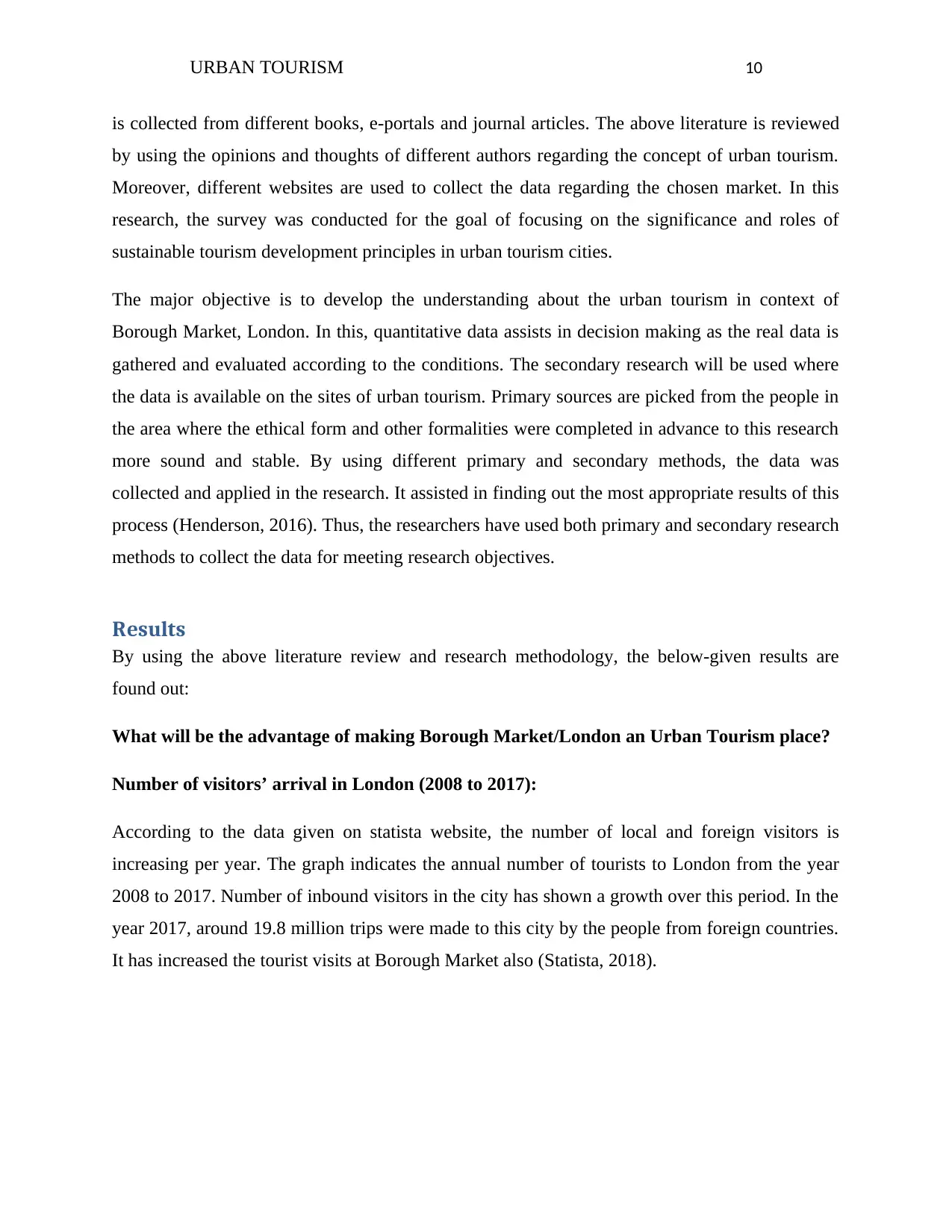
URBAN TOURISM 10
is collected from different books, e-portals and journal articles. The above literature is reviewed
by using the opinions and thoughts of different authors regarding the concept of urban tourism.
Moreover, different websites are used to collect the data regarding the chosen market. In this
research, the survey was conducted for the goal of focusing on the significance and roles of
sustainable tourism development principles in urban tourism cities.
The major objective is to develop the understanding about the urban tourism in context of
Borough Market, London. In this, quantitative data assists in decision making as the real data is
gathered and evaluated according to the conditions. The secondary research will be used where
the data is available on the sites of urban tourism. Primary sources are picked from the people in
the area where the ethical form and other formalities were completed in advance to this research
more sound and stable. By using different primary and secondary methods, the data was
collected and applied in the research. It assisted in finding out the most appropriate results of this
process (Henderson, 2016). Thus, the researchers have used both primary and secondary research
methods to collect the data for meeting research objectives.
Results
By using the above literature review and research methodology, the below-given results are
found out:
What will be the advantage of making Borough Market/London an Urban Tourism place?
Number of visitors’ arrival in London (2008 to 2017):
According to the data given on statista website, the number of local and foreign visitors is
increasing per year. The graph indicates the annual number of tourists to London from the year
2008 to 2017. Number of inbound visitors in the city has shown a growth over this period. In the
year 2017, around 19.8 million trips were made to this city by the people from foreign countries.
It has increased the tourist visits at Borough Market also (Statista, 2018).
is collected from different books, e-portals and journal articles. The above literature is reviewed
by using the opinions and thoughts of different authors regarding the concept of urban tourism.
Moreover, different websites are used to collect the data regarding the chosen market. In this
research, the survey was conducted for the goal of focusing on the significance and roles of
sustainable tourism development principles in urban tourism cities.
The major objective is to develop the understanding about the urban tourism in context of
Borough Market, London. In this, quantitative data assists in decision making as the real data is
gathered and evaluated according to the conditions. The secondary research will be used where
the data is available on the sites of urban tourism. Primary sources are picked from the people in
the area where the ethical form and other formalities were completed in advance to this research
more sound and stable. By using different primary and secondary methods, the data was
collected and applied in the research. It assisted in finding out the most appropriate results of this
process (Henderson, 2016). Thus, the researchers have used both primary and secondary research
methods to collect the data for meeting research objectives.
Results
By using the above literature review and research methodology, the below-given results are
found out:
What will be the advantage of making Borough Market/London an Urban Tourism place?
Number of visitors’ arrival in London (2008 to 2017):
According to the data given on statista website, the number of local and foreign visitors is
increasing per year. The graph indicates the annual number of tourists to London from the year
2008 to 2017. Number of inbound visitors in the city has shown a growth over this period. In the
year 2017, around 19.8 million trips were made to this city by the people from foreign countries.
It has increased the tourist visits at Borough Market also (Statista, 2018).
Paraphrase This Document
Need a fresh take? Get an instant paraphrase of this document with our AI Paraphraser
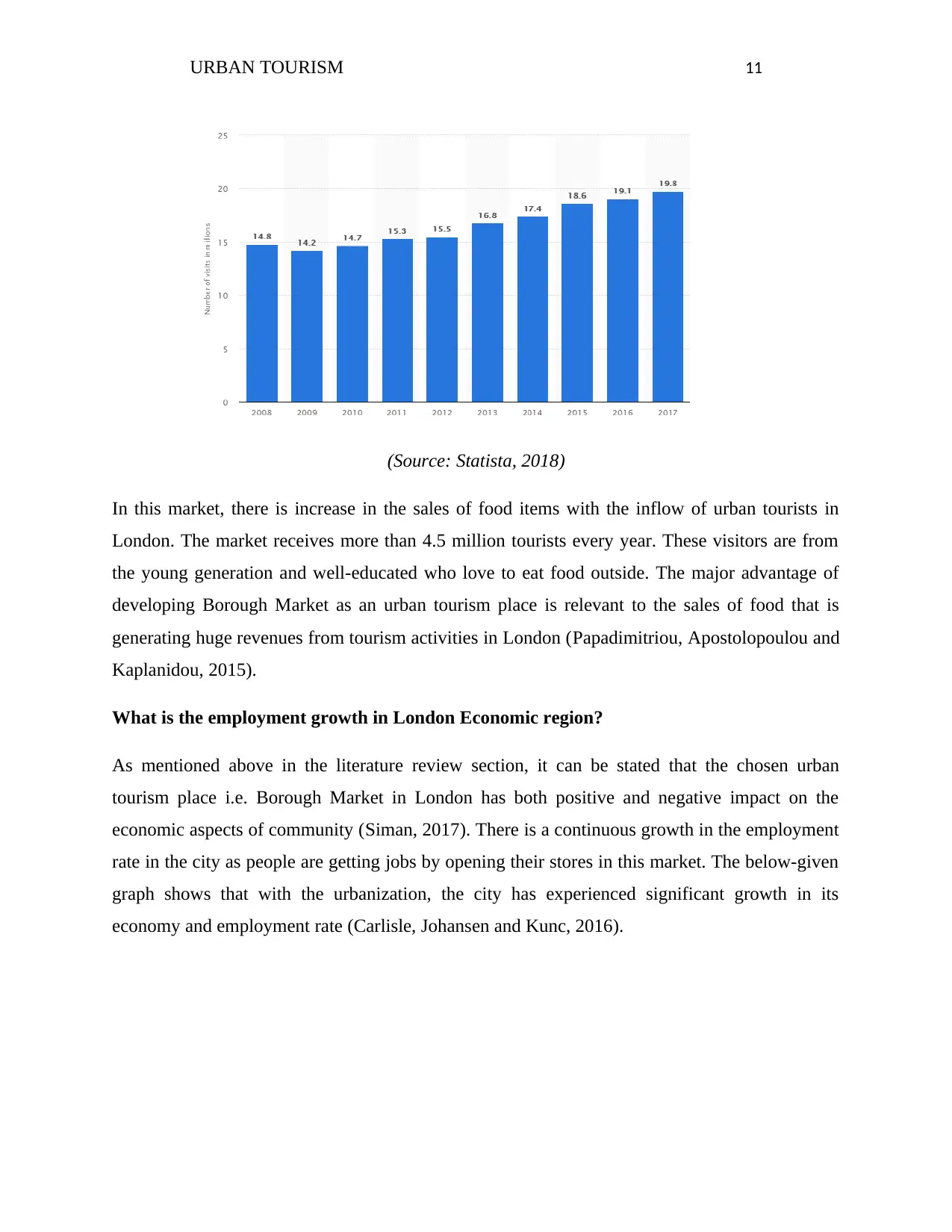
URBAN TOURISM 11
(Source: Statista, 2018)
In this market, there is increase in the sales of food items with the inflow of urban tourists in
London. The market receives more than 4.5 million tourists every year. These visitors are from
the young generation and well-educated who love to eat food outside. The major advantage of
developing Borough Market as an urban tourism place is relevant to the sales of food that is
generating huge revenues from tourism activities in London (Papadimitriou, Apostolopoulou and
Kaplanidou, 2015).
What is the employment growth in London Economic region?
As mentioned above in the literature review section, it can be stated that the chosen urban
tourism place i.e. Borough Market in London has both positive and negative impact on the
economic aspects of community (Siman, 2017). There is a continuous growth in the employment
rate in the city as people are getting jobs by opening their stores in this market. The below-given
graph shows that with the urbanization, the city has experienced significant growth in its
economy and employment rate (Carlisle, Johansen and Kunc, 2016).
(Source: Statista, 2018)
In this market, there is increase in the sales of food items with the inflow of urban tourists in
London. The market receives more than 4.5 million tourists every year. These visitors are from
the young generation and well-educated who love to eat food outside. The major advantage of
developing Borough Market as an urban tourism place is relevant to the sales of food that is
generating huge revenues from tourism activities in London (Papadimitriou, Apostolopoulou and
Kaplanidou, 2015).
What is the employment growth in London Economic region?
As mentioned above in the literature review section, it can be stated that the chosen urban
tourism place i.e. Borough Market in London has both positive and negative impact on the
economic aspects of community (Siman, 2017). There is a continuous growth in the employment
rate in the city as people are getting jobs by opening their stores in this market. The below-given
graph shows that with the urbanization, the city has experienced significant growth in its
economy and employment rate (Carlisle, Johansen and Kunc, 2016).
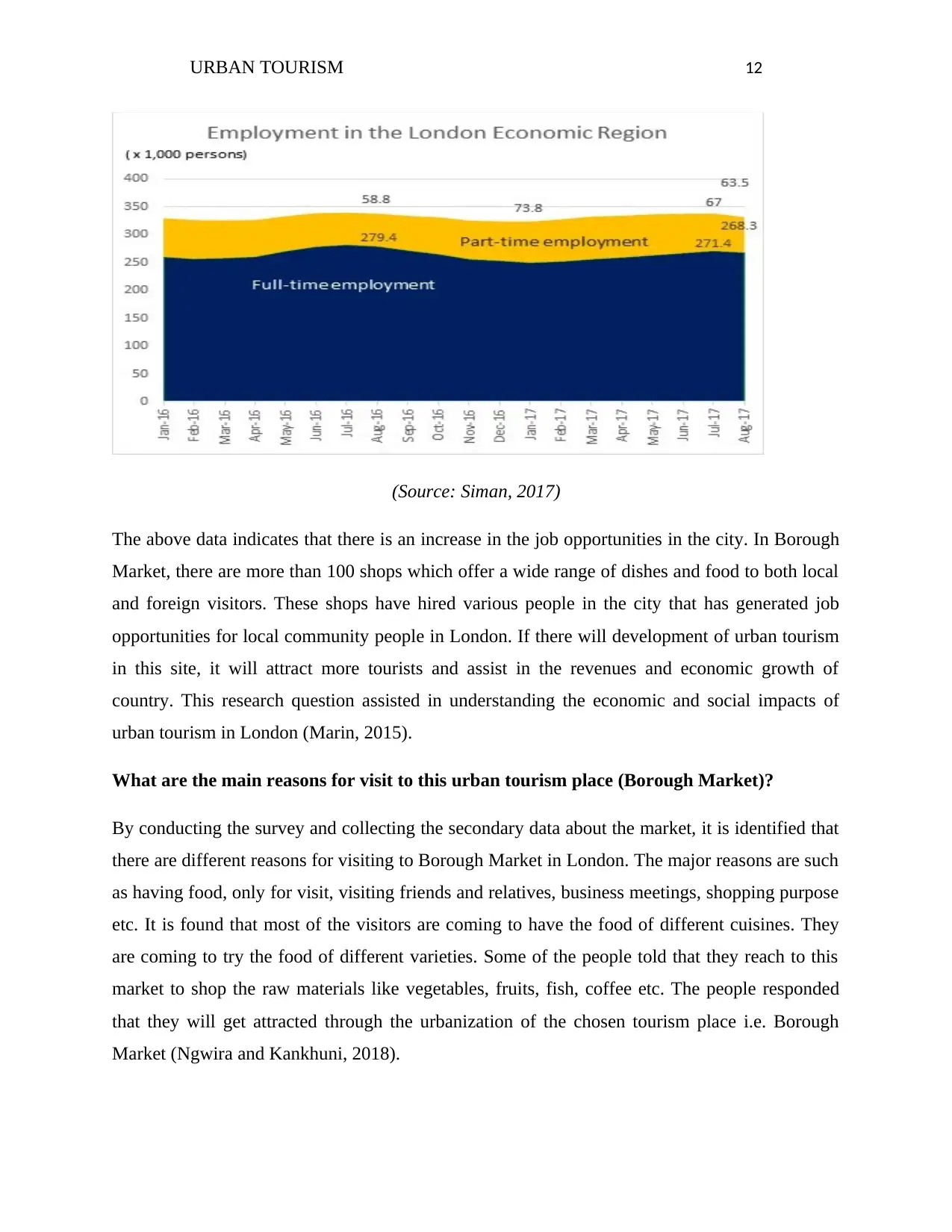
URBAN TOURISM 12
(Source: Siman, 2017)
The above data indicates that there is an increase in the job opportunities in the city. In Borough
Market, there are more than 100 shops which offer a wide range of dishes and food to both local
and foreign visitors. These shops have hired various people in the city that has generated job
opportunities for local community people in London. If there will development of urban tourism
in this site, it will attract more tourists and assist in the revenues and economic growth of
country. This research question assisted in understanding the economic and social impacts of
urban tourism in London (Marin, 2015).
What are the main reasons for visit to this urban tourism place (Borough Market)?
By conducting the survey and collecting the secondary data about the market, it is identified that
there are different reasons for visiting to Borough Market in London. The major reasons are such
as having food, only for visit, visiting friends and relatives, business meetings, shopping purpose
etc. It is found that most of the visitors are coming to have the food of different cuisines. They
are coming to try the food of different varieties. Some of the people told that they reach to this
market to shop the raw materials like vegetables, fruits, fish, coffee etc. The people responded
that they will get attracted through the urbanization of the chosen tourism place i.e. Borough
Market (Ngwira and Kankhuni, 2018).
(Source: Siman, 2017)
The above data indicates that there is an increase in the job opportunities in the city. In Borough
Market, there are more than 100 shops which offer a wide range of dishes and food to both local
and foreign visitors. These shops have hired various people in the city that has generated job
opportunities for local community people in London. If there will development of urban tourism
in this site, it will attract more tourists and assist in the revenues and economic growth of
country. This research question assisted in understanding the economic and social impacts of
urban tourism in London (Marin, 2015).
What are the main reasons for visit to this urban tourism place (Borough Market)?
By conducting the survey and collecting the secondary data about the market, it is identified that
there are different reasons for visiting to Borough Market in London. The major reasons are such
as having food, only for visit, visiting friends and relatives, business meetings, shopping purpose
etc. It is found that most of the visitors are coming to have the food of different cuisines. They
are coming to try the food of different varieties. Some of the people told that they reach to this
market to shop the raw materials like vegetables, fruits, fish, coffee etc. The people responded
that they will get attracted through the urbanization of the chosen tourism place i.e. Borough
Market (Ngwira and Kankhuni, 2018).
⊘ This is a preview!⊘
Do you want full access?
Subscribe today to unlock all pages.

Trusted by 1+ million students worldwide
1 out of 16
Related Documents
Your All-in-One AI-Powered Toolkit for Academic Success.
+13062052269
info@desklib.com
Available 24*7 on WhatsApp / Email
![[object Object]](/_next/static/media/star-bottom.7253800d.svg)
Unlock your academic potential
Copyright © 2020–2025 A2Z Services. All Rights Reserved. Developed and managed by ZUCOL.





